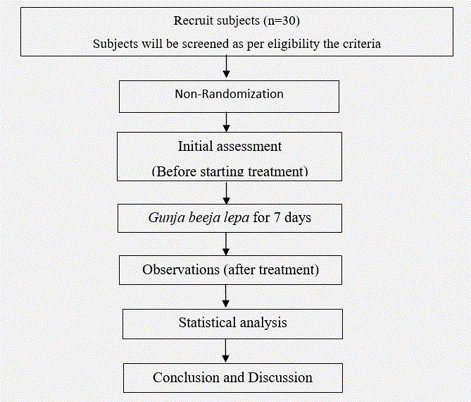Abstract
The most common musculoskeletal disorder affecting the movement of legs is low back pain. Among the affected patients, 40% have ridiculer pain, and these cases can be classified under the umbrella of the sciatic syndrome. Low back pain is extraordinarily common, frequently resulting from degenerative arthritis of the lumbosacral spine. The annual prevalence of disc-related sciatica in the general population is estimated at 2.2%. Sciatica is characterised by constant aching pain which felt in the lumbar region may radiate to the buttock, thigh, calf and foot. Acharaya Charaka explained Gridhrasi in eighty types of nanatmaja Vata vikara. The present study is aimed at evaluating the effect of Gunja (Abrus precatorius Linn.) Beeja lepa in the management of Gridhrasi (Sciatica) and thereby assessing the changes in quality life. The present study is designed as a Non-randomized controlled clinical study, in which a minimum of 30 patients will be enrolled. Gunja beej lepa will be administered external application two times in a day with lukewarm water. Assessment will be recorded on the 3rd, 5th, 7th, 14th and 28th day. Changes will be observed in subjective parameters such as Ruk (pain) Toda (pin pricking sensation) Stambha (Stiffness), Spandana (Fasciculation) and objective parameters such as measuring the changes in the angle of elevation of the leg by SLR Test, Sciatica Bothersomeness Index and Sciatica Frequency Index before and after the treatment. Suitable conclusion will be drawn post completion of the trial.
Full text article
Authors

This work is licensed under a Creative Commons Attribution-NonCommercial-NoDerivatives 4.0 International License.

